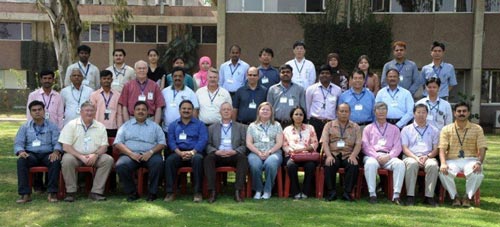September, 2004
Should Africa embrace genetically modified crops to help feed its hungry people? That question is explored by a recent paper entitled “Debunking the Myths of GM Crops for Africa: The Case of Bt Maize in Kenya.” The paper compares the benefits of genetically modified crops to information available on the risks, and finds that most objections are not backed by evidence. Hugo De Groote, Stephen Mugo, and David Bergvinson from CIMMYT, along with Ben Odhiambo of the Kenya Agricultural Research Institute, conducted the study, which argues for a discussion based on scientific evidence and evaluation of potential benefits against concerns.
Genetically modified crops have been successful in many countries, including Canada and the US, where they have increased yields, lowered labor and cultivation costs, and reduced the use of chemical inputs. Genetic engineering has the potential to enhance food security and nutritional quality in ways not possible with conventional technology. Because the technology is contained in the seed, it is easy to distribute to farmers. This is particularly important in Africa, where extension services have largely collapsed and transport infrastructure is poor.
Concerns about deploying genetically modified crops in Africa include food safety, ethics, environmental risk, loss of landrace biodiversity, and the lack of appropriate biosafety regulations. Although long-term effects need to be analyzed, current studies by national and international organizations reveal no demonstrated toxic or nutritionally harmful effects of foods derived from genetically modified crops.
Sounding Out Public Opinion
The study by de Groote and his colleagues focused on Kenya, where maize, the main food crop, is planted on 30% of arable lands. It drew on a variety of data sources, including participatory rural appraisals and farmer and consumer surveys. De Groote thinks it is important to make research results understandable to the general public so everyone can participate in the debate.
To gauge awareness and attitudes about genetically modified crops, the researchers interviewed 604 consumers, only half of whom were aware of them. Many appreciated the benefits but worried about potential negative effects on health and the environment, especially on local plant varieties. De Groote says consumers are increasingly aware of genetically modified food and generally accept it, but their concerns about environmental safety and biodiversity have to be addressed.
Several seed companies in Kenya have expressed interest in producing and distributing Bt maize seed, which offers an effective and practical method for reducing stem borer damage in maize. Genetically engineered Bt maize contains a gene from the soil-dwelling bacteria Bacillus thuringiensis, which produces a toxin that helps control certain pests but is not harmful to humans or livestock. The Bt gene was first introduced into the commercial maize market in 1996. It has provided control for many pests and could help decrease pesticide use.
“The major surprise was that, contrary to the usual claims, Bt maize is very likely to benefit poor farmers and small seed companies,” says de Groote. “Stem borers are a real concern for farmers, especially in low-potential coastal and dry areas.”
Farmers in Kenya lose 400,000 tons, or about 14%, of their maize to stem borers. That is roughly the amount the country imports each year. De Groote says Bt maize alone will not solve this problem, but could help reduce losses and increase food security.
The IRMA Project
In 1999, the Insect Resistant Maize for Africa (IRMA) project was launched in Kenya to develop borer resistant varieties using both conventional breeding and biotechnology. Kenya already had experience with genetically modified crops and had biosafety policies in place. IRMA, a collaborative project between CIMMYT and the Kenya Agricultural Research Institute, receives financial support from the Syngenta Foundation for Sustainable Agriculture.
Before initiating the project, all parties involved agreed that transformed plants would carry only the gene of interest, without marker genes; that transgenic crops would only be developed for countries with appropriate biosafety regulations; and that only genes in the public domain would be used. They also agreed that the project would work under the highest scientific standards. When the project ends, other countries in Africa will be able to evaluate results from Kenya’s experience and decide for themselves which path to follow.
“I hope that the results will be accepted not only by the scientific community but also by the general population, in Africa as well as in the developed world,” says de Groote. “I also hope they will put to rest some of the major concerns about Bt maize for Africa.”
To make informed choices possible, the researchers contend that scientists in Africa need hands-on experience with the new technology. They need to test and adapt it using the appropriate regulatory framework and precautions. Further, the researchers believe that the technologies need to be developed in a participatory approach, since African farmers and consumers have the right to choose technologies based on the best knowledge available. They should not be denied the chance to improve their livelihoods as a result of an academic debate in which they are not included.
For more information: Hugo De Groote or Stephen Mugo
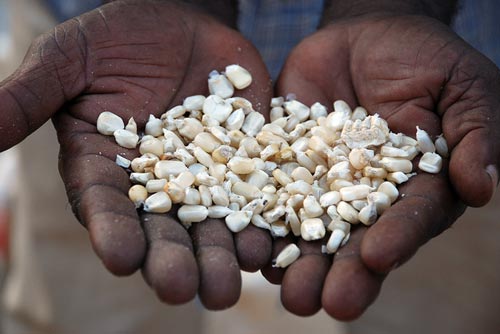 “This project is a rare example of a public-private partnership capable of delivering products to farmers,” said Mike Robinson of the Syngenta Foundation for Sustainable Agriculture (SFSA) at the Affordable, Accessible, Asian (AAA) Drought Tolerant Maize Annual Meeting organized by CIMMYT-Asia at the International Crops Research Institute for the Semi-Arid Tropics (ICRISAT) campus during 20-21 May 2013.
“This project is a rare example of a public-private partnership capable of delivering products to farmers,” said Mike Robinson of the Syngenta Foundation for Sustainable Agriculture (SFSA) at the Affordable, Accessible, Asian (AAA) Drought Tolerant Maize Annual Meeting organized by CIMMYT-Asia at the International Crops Research Institute for the Semi-Arid Tropics (ICRISAT) campus during 20-21 May 2013.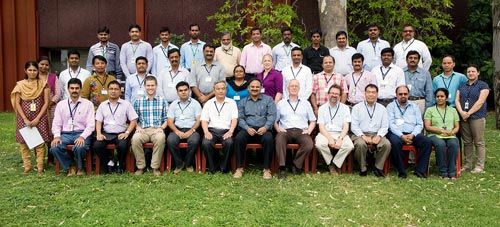
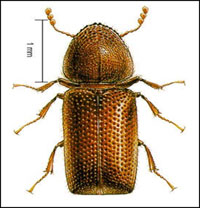 The larger grain borer is taking a beating from CIMMYT breeders in Kenya as new African maize withstands the onslaught of one of the most damaging pests.
The larger grain borer is taking a beating from CIMMYT breeders in Kenya as new African maize withstands the onslaught of one of the most damaging pests. Even in Latin America, where it has co-evolved with natural predators, losses are significant. In Africa, where there are no similar predators to control the insect, its spread has been most dramatic. Attempts to introduce some of those predators to Africa to control the borer (a technique called biological control) have met with limited success and regionally concerted action is essential if biological control is to be effective across borer-infested areas. Researchers also studied the habits of the borer, hoping to find ways to reduce the damage it does. They discovered that it needs a solid platform, such as that provided by maize kernels still on the cob, before it will bore into a kernel. Unfortunately African farmers often store maize on the cob, increasing the potential for borer damage. By shelling the maize and storing the kernels off the cob, the damage can be reduced by small amounts, but losses are still very high. This is what makes the development of new varieties, where the resistance lies in the seed, so exciting.
Even in Latin America, where it has co-evolved with natural predators, losses are significant. In Africa, where there are no similar predators to control the insect, its spread has been most dramatic. Attempts to introduce some of those predators to Africa to control the borer (a technique called biological control) have met with limited success and regionally concerted action is essential if biological control is to be effective across borer-infested areas. Researchers also studied the habits of the borer, hoping to find ways to reduce the damage it does. They discovered that it needs a solid platform, such as that provided by maize kernels still on the cob, before it will bore into a kernel. Unfortunately African farmers often store maize on the cob, increasing the potential for borer damage. By shelling the maize and storing the kernels off the cob, the damage can be reduced by small amounts, but losses are still very high. This is what makes the development of new varieties, where the resistance lies in the seed, so exciting.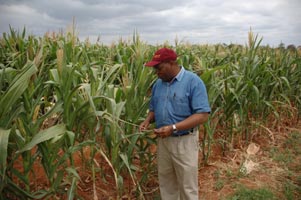 CIMMYT researchers found resistance to the borer in the Center’s germplasm bank, in maize seed originally from the Caribbean. The bank holds 25,000 unique collections of native maize races. By using conventional plant breeding techniques, crossing those plants with maize already adapted to the conditions found in eastern Africa, Mugo and the breeding team were able to combine the resistance of the Caribbean maize with the key traits valued by Kenyan maize farmers. The maize was tested for resistance at the KARI research station in Kiboko, Kenya. Larger grain borers were placed in glass jars with a known weight of maize. Weight changes to the maize and a visual assessment of damage were recorded, allowing researchers to select the best lines. The result is new maize varieties that will benefit farmers in Kenya and help reduce Kenya’s dependence on imported maize for national food security.
CIMMYT researchers found resistance to the borer in the Center’s germplasm bank, in maize seed originally from the Caribbean. The bank holds 25,000 unique collections of native maize races. By using conventional plant breeding techniques, crossing those plants with maize already adapted to the conditions found in eastern Africa, Mugo and the breeding team were able to combine the resistance of the Caribbean maize with the key traits valued by Kenyan maize farmers. The maize was tested for resistance at the KARI research station in Kiboko, Kenya. Larger grain borers were placed in glass jars with a known weight of maize. Weight changes to the maize and a visual assessment of damage were recorded, allowing researchers to select the best lines. The result is new maize varieties that will benefit farmers in Kenya and help reduce Kenya’s dependence on imported maize for national food security.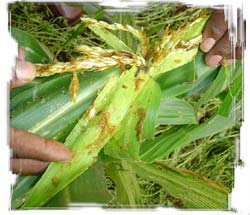 Convincing risk-averse, resource-poor farmers to adopt a good technology is hard enough when they can see the enemy, but what if the enemy hides from view?
Convincing risk-averse, resource-poor farmers to adopt a good technology is hard enough when they can see the enemy, but what if the enemy hides from view?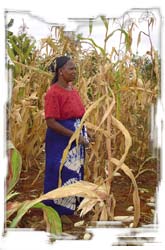
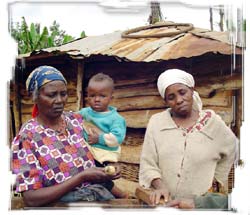
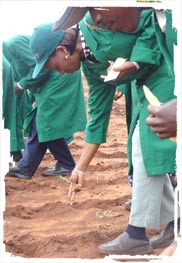 Kenya broke historic agricultural ground in a protected field on May 27 when it sowed its first transgenic maize seeds into local soil. Supported by the Syngenta Foundation for Sustainable Agriculture and the Rockefeller Foundation, this experiment is the first of its kind in the region. The Bt maize plants that sprout will be resistant to stem borer, an insect that drills into the maize stalk and causes significant losses to Kenyan harvests.
Kenya broke historic agricultural ground in a protected field on May 27 when it sowed its first transgenic maize seeds into local soil. Supported by the Syngenta Foundation for Sustainable Agriculture and the Rockefeller Foundation, this experiment is the first of its kind in the region. The Bt maize plants that sprout will be resistant to stem borer, an insect that drills into the maize stalk and causes significant losses to Kenyan harvests.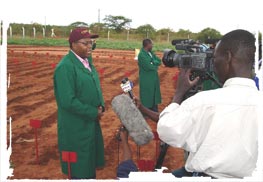
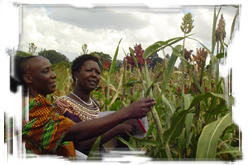 African maize farmers who will grow transgenic maize varieties resistant to one of the crop’s most damaging pests—the maize stem borer—learn that to keep borers at bay, some must survive.
African maize farmers who will grow transgenic maize varieties resistant to one of the crop’s most damaging pests—the maize stem borer—learn that to keep borers at bay, some must survive. The official opening on 23 June 2004 of a level-two biosafety greenhouse in Nairobi, Kenya was marked by happy fanfare, but more importantly, a serious commitment from the highest levels to use biotechnology to help solve Africa’s pressing agricultural problems.
The official opening on 23 June 2004 of a level-two biosafety greenhouse in Nairobi, Kenya was marked by happy fanfare, but more importantly, a serious commitment from the highest levels to use biotechnology to help solve Africa’s pressing agricultural problems.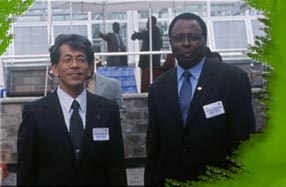 The President of Kenya, his Excellency the Hon. Mwai Kibaki, officially launched the facility. He was joined by Masa Iwanaga, CIMMYT’s Director General; Romano Kiome, Director of KARI; Andrew Bennett, Executive Director of the Syngenta Foundation for Sustainable Agriculture, which provided funds for the new facility; Shivaji Pandey, Director of CIMMYT’s African Livelihoods Program (ALP); and the Hon. Kipruto Arap Kirwa, Minister of Agriculture.
The President of Kenya, his Excellency the Hon. Mwai Kibaki, officially launched the facility. He was joined by Masa Iwanaga, CIMMYT’s Director General; Romano Kiome, Director of KARI; Andrew Bennett, Executive Director of the Syngenta Foundation for Sustainable Agriculture, which provided funds for the new facility; Shivaji Pandey, Director of CIMMYT’s African Livelihoods Program (ALP); and the Hon. Kipruto Arap Kirwa, Minister of Agriculture.
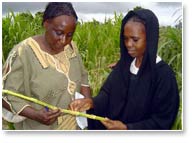 To get the ball rolling, five scientists were designated to attend an intensive two-week course on regulatory issues and processes, conducted in August at Ghent University, Belgium. The scientists were involved in either IRMA II or regulatory processes: A. Pellegrineschi and S. Mugo (CIMMYT), M. Mulaa and S. Gichuki (KARI), and R. Onamu (KEPHIS). On the heels of the regulatory workshop, a two-day workshop to develop, plan and incorporate regulatory activities in the IRMA II project plan was held in Nairobi in September 2004. Twenty-one participants from seven institutions attended the workshop: KARI, CIMMYT, KEPHIS, National Council for Science and Technology (NCST), Syngenta Foundation for Sustainable Agriculture, African Agricultural Technology Foundation (AATF), and International Biotech Regulatory Services. The objectives of the meeting were to (1) update the status of Bt maize in IRMA project; (2) identify information needed for a dossier on Bt genes to be deployed by the project;(3) determine sources of the needed information and identify gaps to be filled through research; (4) determine activities needed to fill the gaps, including resources and assigning responsibilities; and (5) update the IRMA II project plan, specifically on regulatory issues. After agreeing on the components of a regulatory package, the team split up into working groups and identified the required information, and developed activities over time, including budgets and responsibilities. Subsequently, a small task group incorporated the regulatory strategies into the project plan and created a revised structure for IRMA II. Ten themes were recommended:
To get the ball rolling, five scientists were designated to attend an intensive two-week course on regulatory issues and processes, conducted in August at Ghent University, Belgium. The scientists were involved in either IRMA II or regulatory processes: A. Pellegrineschi and S. Mugo (CIMMYT), M. Mulaa and S. Gichuki (KARI), and R. Onamu (KEPHIS). On the heels of the regulatory workshop, a two-day workshop to develop, plan and incorporate regulatory activities in the IRMA II project plan was held in Nairobi in September 2004. Twenty-one participants from seven institutions attended the workshop: KARI, CIMMYT, KEPHIS, National Council for Science and Technology (NCST), Syngenta Foundation for Sustainable Agriculture, African Agricultural Technology Foundation (AATF), and International Biotech Regulatory Services. The objectives of the meeting were to (1) update the status of Bt maize in IRMA project; (2) identify information needed for a dossier on Bt genes to be deployed by the project;(3) determine sources of the needed information and identify gaps to be filled through research; (4) determine activities needed to fill the gaps, including resources and assigning responsibilities; and (5) update the IRMA II project plan, specifically on regulatory issues. After agreeing on the components of a regulatory package, the team split up into working groups and identified the required information, and developed activities over time, including budgets and responsibilities. Subsequently, a small task group incorporated the regulatory strategies into the project plan and created a revised structure for IRMA II. Ten themes were recommended: